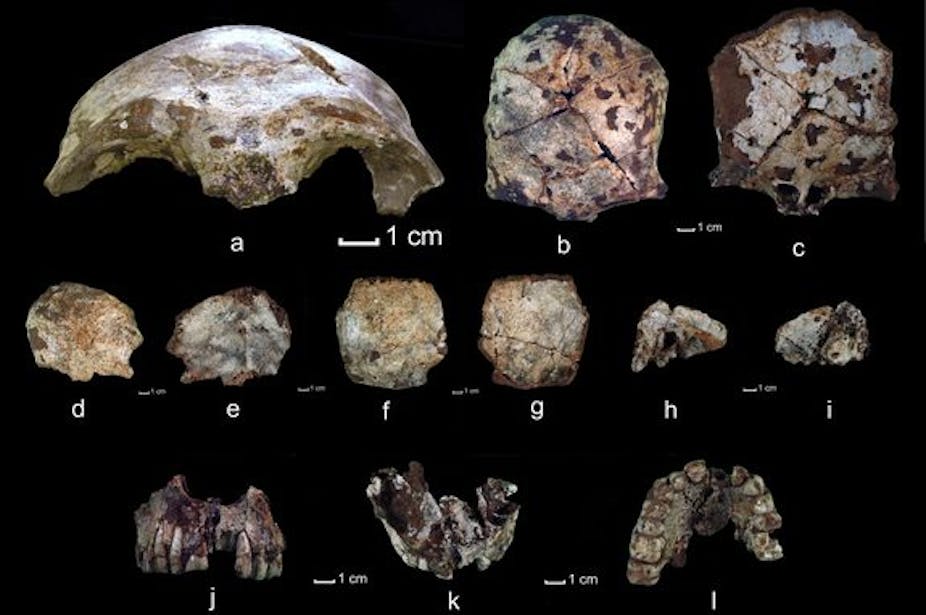I would like to rectify a couple of statements made by Darren Curnoe in his recent Conversation article which, in turn, was a reaction to an article I published recently with my colleagues in Proceedings of the National Academy of Sciences (PNAS).
Allow me to outline our research in very simple terms. In a cave called Tam Pa Ling (Cave of the Monkeys) in the Annamitic Chain in Northern Laos, we found a fragmented human skull directly dated to 63,000 years ago.
The stratigraphy analysis of the soil of the cave showed the different layers had remained undisturbed since they were deposited.

We combined different dating techniques to arrive at an age of 46,000 to 51,000 years old for the layers that yielded the fossil. The greater age of the fossil comparative to these dates could be explained by the fact that the fossil could have spent several thousands of years outside the cave before being washed into the cave with the sediment.
The main thing the TPL1 fossil (as pictured below) shows is that anatomically modern humans, as we are today, were already populating southeast Asia about 50,000 to 60,000 years ago – some 20,000 years earlier than was commonly accepted before our find.
Another consequence of the find is that we now know, after leaving Africa, modern humans quickly colonised Eurasia towards southeast Asia, using inland routes and not just following the coasts.
In his article, Curnoe suggests it’s of general knowledge that the filling of the Tam Pa Ling cave had been disturbed after being deposited, stating:
We know the Cave of Monkeys seems to have been disturbed, as the entire upper half of the soil has been washed out, replaced with a substantially younger soil.
If Curnoe was right, it would mean the skull we found could be far younger than our dates show, and that the sediment deposits would be incoherent.

But this is absolutely not the case. Curnoe (and he is the only one, as far as I know) bases his statement on the gap seen between the layers composing the soil in the cave.
Actually, the cave was filled with sediments between 46,000 and 51,000 years ago, the filling was interrupted for thousands of years, and then the filling continued from 2,700 years ago to the present day.
In other words, from 46,000 to 2,700 years ago, no more sediment was deposited inside the cave. My colleagues and I clearly explained within the main text of our PNAS article and in more details in the supplementary information that this gap in the age could have several origins.
The most likely explanation indicates the entrance of the cave was closed (possibly by fallen rocks and sediment) for more than 40,000 years.
Another fact that supports an undisturbed stratigraphy (arranged of rock and soil layers) in the cave is that several parallel laminae (layers) can be followed throughout the main excavation to the entire floor of the cave, as attested within the two other test pits on the opposite side. Once again all these details are given either in the main text or in the supplementary information.
The second incorrect statement made by Curnoe is that our dating of the deposits could be wrong, based on, according to him, “inverted 14C dates”. In his article we read:
Dates using the radiocarbon method are also out of order (inverted), suggesting the soils have been disturbed once they were formed.
We also read about the the apparent “conflict” (to use Curnoe’s word) that would exist between the direct dating of the skull itself to 63,000 years ago and the sediment dating to 46-51,000 years ago. From this, he goes on to surmise that:
These apparent conflicts would need to be resolved before claims for the oldest modern human can be accepted.
As already explained above, the skull could be much older than the sediment given it may have spent thousands of years outside the Tam Pa Ling cave before being washed in.

Anyone reading the stratigraphy column in our article would see that the 14C dates are not “inverted”, as Curnoe – rather, they increase with the deepness. When combined, the results of the datings indicate that the fossil was buried between 46,000 and 51,000 years ago.
Given the fossil washed into the cave, the sedimentary burial occurred before 46,000 years ago, making it of greater antiquity.
Here again, it is easy to understand that the direct dating of the fossil to 63,000 is not contradictory with the dating of the sediments to 46-51,000 but simply shows that the fossil has spent several thousand of years outside the cave before being washed in within the sediment.

It is true that in the morphological comparison in my article, I did not take into consideration the material studied by Darren Curnoe from Southern China – a point he makes in his Conversation article.
That’s because this material was very similar, according to what I’ve seen and read, to some other material from northern Indochina.
Our discovery shows determination is often the key to success and that more work needs to be done in the remote regions of northern Indochina where, we now know, the first modern humans are to be found.
Only continuing fieldwork can eventually bring more fossils in a secured dating context, which will definitely provide greater clarity to the human origin debate.
Further reading:
- Cave of the Monkeys find complicates our Asia story – Darren Curnoe, The Conversation

